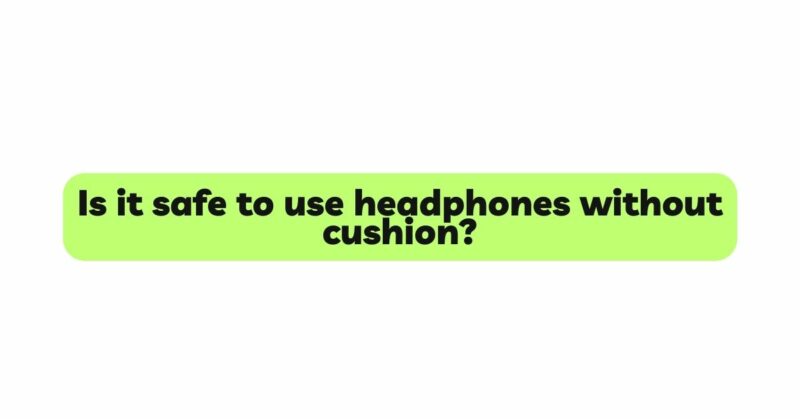Headphones have become an integral part of modern life, providing us with immersive audio experiences for music, podcasts, gaming, and more. Ear cushions, the soft padding that surrounds the ears, play a vital role in ensuring comfort, noise isolation, and sound quality during headphone use. However, there are instances where users may opt to use headphones without cushions, either due to preference, wear and tear, or accidental removal. In this article, we will explore the safety implications of using headphones without cushions, focusing on the risks to hearing health and overall user comfort.
Understanding the Purpose of Ear Cushions:
Ear cushions serve several important functions:
- Comfort: One of the primary purposes of ear cushions is to provide a comfortable listening experience. They act as a cushion between the headphone’s driver and the ears, preventing direct contact with hard surfaces, and reducing discomfort during extended use.
- Noise Isolation: The design of ear cushions creates a seal around the ears, isolating external noise and enhancing the audio experience by allowing users to focus on their content without distractions.
- Sound Quality: Ear cushions contribute to the acoustic properties of headphones, affecting the sound signature, bass response, and soundstage. The materials and design of ear cushions can subtly impact the overall audio performance.
Safety Implications of Using Headphones Without Cushions:
- Impact on Comfort: Using headphones without ear cushions can lead to discomfort and even pain during prolonged listening sessions. Without the soft padding, the hard surfaces of the headphones can press directly against the ears, causing pressure points and irritation. Moreover, the absence of ear cushions can lead to an insecure and potentially unstable fit, further compromising comfort.
- Risk of Ear Injuries: Headphones without cushions may expose the ears to the hard components of the headphones, such as the driver or internal mechanics. Prolonged contact with these surfaces can lead to friction-related injuries, abrasions, or even skin irritation.
- Reduced Noise Isolation: Ear cushions play a crucial role in providing effective noise isolation by forming a seal around the ears. Without ear cushions, the headphones’ ability to block out external noise is significantly compromised. As a result, users may turn up the volume to compensate, potentially leading to hearing damage.
- Impact on Sound Quality: In addition to comfort and safety concerns, using headphones without ear cushions can negatively impact sound quality. The absence of proper cushioning and sealing can lead to a loss of bass response, reduced overall sound quality, and a less immersive audio experience.
Hearing Health and the Importance of Noise Isolation:
Noise-induced hearing loss (NIHL) is a significant concern when using headphones without proper noise isolation. NIHL occurs when the sensitive hair cells in the inner ear are damaged by exposure to loud sounds. Headphones without ear cushions allow external noise to leak in, which may prompt users to raise the volume to compensate for background noise. Prolonged exposure to high volume levels can lead to permanent hearing damage and other hearing-related issues.
Tips for Safe Headphone Use:
- Use Headphones with Cushions: To ensure comfort, sound quality, and hearing protection, always use headphones with cushions. Invest in high-quality replacement cushions if the original ones are worn out or damaged.
- Choose Noise-Isolating Headphones: When selecting headphones, opt for models that offer effective noise isolation. Noise-isolating headphones with well-designed ear cushions can significantly reduce the need to increase volume levels, protecting your hearing health.
- Take Breaks and Monitor Volume Levels: Regardless of whether you use headphones with or without cushions, it is essential to take breaks from extended listening sessions. Additionally, keep the volume at a safe and comfortable level. As a general rule, follow the “60/60 rule” – listen at no more than 60% of the maximum volume for no more than 60 minutes at a time.
- Regularly Check for Wear and Tear: Inspect your headphones regularly to ensure that the ear cushions are in good condition. If you notice signs of wear or damage, replace them promptly to maintain comfort and sound quality while preserving your hearing health.
Conclusion:
Using headphones without ear cushions may seem like a minor adjustment, but it can have significant safety implications. Ear cushions provide crucial comfort, noise isolation, and sound quality benefits, while also contributing to hearing protection by allowing users to listen at safer volume levels. The absence of ear cushions can lead to discomfort, reduce noise isolation, and negatively impact sound quality.
To ensure a safe and enjoyable listening experience, always use headphones with proper ear cushions, choose noise-isolating models, and monitor volume levels. Prioritizing hearing health and investing in high-quality headphones with cushions will not only enhance your listening pleasure but also safeguard your most valuable sensory asset: your hearing.


